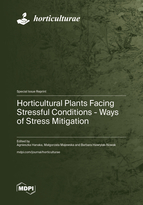Horticultural Plants Facing Stressful Conditions - Ways of Stress Mitigation
A special issue of Horticulturae (ISSN 2311-7524). This special issue belongs to the section "Biotic and Abiotic Stress".
Deadline for manuscript submissions: closed (31 May 2023) | Viewed by 28024
Special Issue Editors
Interests: plant physiology; plant response to abiotic and biotic stress factors; metal phytotoxicity; enzymatic and non-enzymatic antioxidants; secondary metabolites; photosynthesis
Special Issues, Collections and Topics in MDPI journals
Interests: metal bioavailability; heavy metal bioremediation; metal-induced stress; rhizosphere microorganisms; plant-growth-promoting microorganisms
Special Issues, Collections and Topics in MDPI journals
Interests: plant physiology; mineral nutrition; stress response and resistance; trace elements; plant ecophysiology
Special Issues, Collections and Topics in MDPI journals
Special Issue Information
Dear Colleagues,
Horticultural plants are exposed to a wide range of environmental stresses. Two types of stresses are distinguished: (1) abiotic stresses (e.g., heavy metals, salinity, heat, drought, chilling, freezing, radiation, nutrient deficit) and (2) biotic stresses (e.g., fungi, bacteria, nematodes, insects). Plants have developed various strategies of survival in and adaptation to adverse habitats. Their responses involve different complex signaling pathways, the effects of which can be investigated at the molecular, cellular, and physiological levels. Under multiple stress conditions, plants synthetize various regulators and biologically active compounds, which cause both biotic and abiotic stress responses. Plant tolerance can emerge not only from endogenic mechanisms, but also from simultaneously enriched microorganisms inhabiting their tissues (endophytes), surfaces (epiphytes), and soils in the vicinity of the roots (rhizosphere). These microorganisms and their metabolites and mineral elements can play an important role in generating genetic and physiological plant responses to stresses. Compiling our knowledge about these cross-linking relations can be helpful in the development of new strategies for increasing the productivity of horticultural crops. The application of natural origin agents will allow us to produce healthy food in a sustainable and environmentally friendly way.
The goal of this Special Issue is to provide deeper insight into the influence of stress factors at the cellular, tissue, organ, and whole plant level. Both non-modified and genetically modified plants are acceptable. Especially welcome are approaches combining stresses and the exploration of a wide range of fields, from anatomy through biochemistry, physiology, molecular biology, and genetics.
Dr. Agnieszka Hanaka
Dr. Małgorzata Majewska
Dr. Barbara Hawrylak-Nowak
Guest Editors
Manuscript Submission Information
Manuscripts should be submitted online at www.mdpi.com by registering and logging in to this website. Once you are registered, click here to go to the submission form. Manuscripts can be submitted until the deadline. All submissions that pass pre-check are peer-reviewed. Accepted papers will be published continuously in the journal (as soon as accepted) and will be listed together on the special issue website. Research articles, review articles as well as short communications are invited. For planned papers, a title and short abstract (about 100 words) can be sent to the Editorial Office for announcement on this website.
Submitted manuscripts should not have been published previously, nor be under consideration for publication elsewhere (except conference proceedings papers). All manuscripts are thoroughly refereed through a single-blind peer-review process. A guide for authors and other relevant information for submission of manuscripts is available on the Instructions for Authors page. Horticulturae is an international peer-reviewed open access monthly journal published by MDPI.
Please visit the Instructions for Authors page before submitting a manuscript. The Article Processing Charge (APC) for publication in this open access journal is 2200 CHF (Swiss Francs). Submitted papers should be well formatted and use good English. Authors may use MDPI's English editing service prior to publication or during author revisions.
Keywords
- abiotic stress
- biotic stress
- cross-tolerance to stresses
- cross-induction of resistance
- biologically active compounds
- exo- and endogenic regulators
- signaling pathways
- genetical and physiological responses
- synergistic and antagonistic effects








